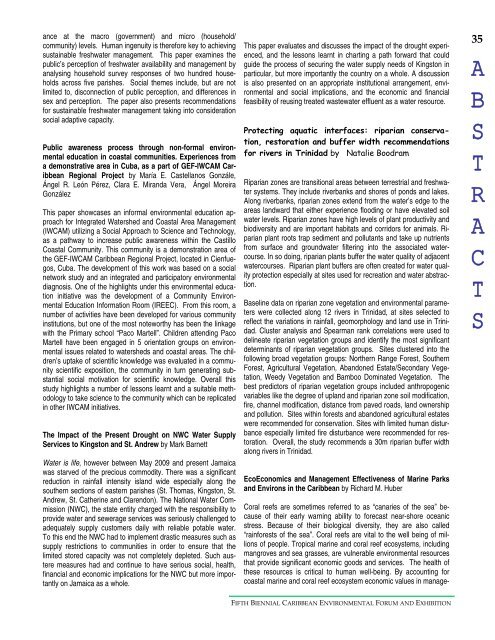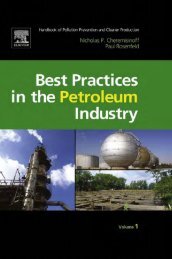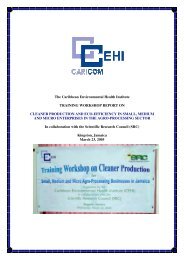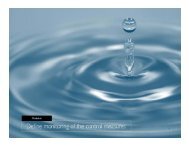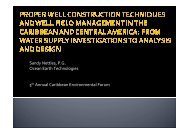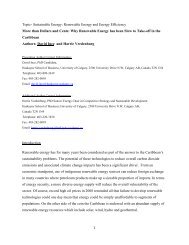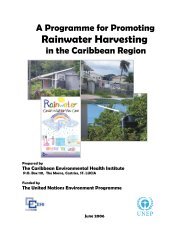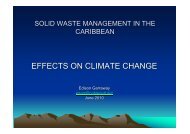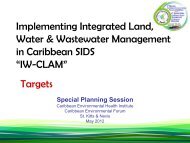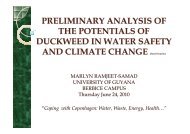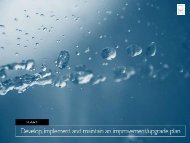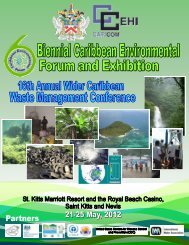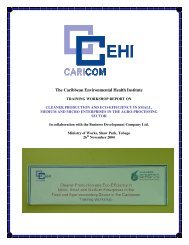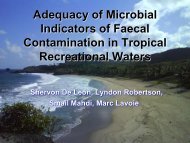conference magazine - Caribbean Environmental Health Institute
conference magazine - Caribbean Environmental Health Institute
conference magazine - Caribbean Environmental Health Institute
Create successful ePaper yourself
Turn your PDF publications into a flip-book with our unique Google optimized e-Paper software.
ance at the macro (government) and micro (household/<br />
community) levels. Human ingenuity is therefore key to achieving<br />
sustainable freshwater management. This paper examines the<br />
public’s perception of freshwater availability and management by<br />
analysing household survey responses of two hundred households<br />
across five parishes. Social themes include, but are not<br />
limited to, disconnection of public perception, and differences in<br />
sex and perception. The paper also presents recommendations<br />
for sustainable freshwater management taking into consideration<br />
social adaptive capacity.<br />
Public awareness process through non-formal environmental<br />
education in coastal communities. Experiences from<br />
a demonstrative area in Cuba, as a part of GEF-IWCAM <strong>Caribbean</strong><br />
Regional Project by María E. Castellanos Gonzále,<br />
Ángel R. León Pérez, Clara E. Miranda Vera, Ángel Moreira<br />
González<br />
This paper showcases an informal environmental education approach<br />
for Integrated Watershed and Coastal Area Management<br />
(IWCAM) utilizing a Social Approach to Science and Technology,<br />
as a pathway to increase public awareness within the Castillo<br />
Coastal Community. This community is a demonstration area of<br />
the GEF-IWCAM <strong>Caribbean</strong> Regional Project, located in Cienfuegos,<br />
Cuba. The development of this work was based on a social<br />
network study and an integrated and participatory environmental<br />
diagnosis. One of the highlights under this environmental education<br />
initiative was the development of a Community <strong>Environmental</strong><br />
Education Information Room (IREEC). From this room, a<br />
number of activities have been developed for various community<br />
institutions, but one of the most noteworthy has been the linkage<br />
with the Primary school “Paco Martell”. Children attending Paco<br />
Martell have been engaged in 5 orientation groups on environmental<br />
issues related to watersheds and coastal areas. The children’s<br />
uptake of scientific knowledge was evaluated in a community<br />
scientific exposition, the community in turn generating substantial<br />
social motivation for scientific knowledge. Overall this<br />
study highlights a number of lessons learnt and a suitable methodology<br />
to take science to the community which can be replicated<br />
in other IWCAM initiatives.<br />
The Impact of the Present Drought on NWC Water Supply<br />
Services to Kingston and St. Andrew by Mark Barnett<br />
Water is life, however between May 2009 and present Jamaica<br />
was starved of the precious commodity. There was a significant<br />
reduction in rainfall intensity island wide especially along the<br />
southern sections of eastern parishes (St. Thomas, Kingston, St.<br />
Andrew, St. Catherine and Clarendon). The National Water Commission<br />
(NWC), the state entity charged with the responsibility to<br />
provide water and sewerage services was seriously challenged to<br />
adequately supply customers daily with reliable potable water.<br />
To this end the NWC had to implement drastic measures such as<br />
supply restrictions to communities in order to ensure that the<br />
limited stored capacity was not completely depleted. Such austere<br />
measures had and continue to have serious social, health,<br />
financial and economic implications for the NWC but more importantly<br />
on Jamaica as a whole.<br />
This paper evaluates and discusses the impact of the drought experienced,<br />
and the lessons learnt in charting a path forward that could<br />
guide the process of securing the water supply needs of Kingston in<br />
particular, but more importantly the country on a whole. A discussion<br />
is also presented on an appropriate institutional arrangement, environmental<br />
and social implications, and the economic and financial<br />
feasibility of reusing treated wastewater effluent as a water resource.<br />
Protecting aquatic interfaces: riparian conservation,<br />
restoration and buffer width recommendations<br />
for rivers in Trinidad by Natalie Boodram<br />
Riparian zones are transitional areas between terrestrial and freshwater<br />
systems. They include riverbanks and shores of ponds and lakes.<br />
Along riverbanks, riparian zones extend from the water’s edge to the<br />
areas landward that either experience flooding or have elevated soil<br />
water levels. Riparian zones have high levels of plant productivity and<br />
biodiversity and are important habitats and corridors for animals. Riparian<br />
plant roots trap sediment and pollutants and take up nutrients<br />
from surface and groundwater filtering into the associated watercourse.<br />
In so doing, riparian plants buffer the water quality of adjacent<br />
watercourses. Riparian plant buffers are often created for water quality<br />
protection especially at sites used for recreation and water abstraction.<br />
Baseline data on riparian zone vegetation and environmental parameters<br />
were collected along 12 rivers in Trinidad, at sites selected to<br />
reflect the variations in rainfall, geomorphology and land use in Trinidad.<br />
Cluster analysis and Spearman rank correlations were used to<br />
delineate riparian vegetation groups and identify the most significant<br />
determinants of riparian vegetation groups. Sites clustered into the<br />
following broad vegetation groups: Northern Range Forest, Southern<br />
Forest, Agricultural Vegetation, Abandoned Estate/Secondary Vegetation,<br />
Weedy Vegetation and Bamboo Dominated Vegetation. The<br />
best predictors of riparian vegetation groups included anthropogenic<br />
variables like the degree of upland and riparian zone soil modification,<br />
fire, channel modification, distance from paved roads, land ownership<br />
and pollution. Sites within forests and abandoned agricultural estates<br />
were recommended for conservation. Sites with limited human disturbance<br />
especially limited fire disturbance were recommended for restoration.<br />
Overall, the study recommends a 30m riparian buffer width<br />
along rivers in Trinidad.<br />
EcoEconomics and Management Effectiveness of Marine Parks<br />
and Environs in the <strong>Caribbean</strong> by Richard M. Huber<br />
Coral reefs are sometimes referred to as “canaries of the sea” because<br />
of their early warning ability to forecast near-shore oceanic<br />
stress. Because of their biological diversity, they are also called<br />
“rainforests of the sea”. Coral reefs are vital to the well being of millions<br />
of people. Tropical marine and coral reef ecosystems, including<br />
mangroves and sea grasses, are vulnerable environmental resources<br />
that provide significant economic goods and services. The health of<br />
these resources is critical to human well-being. By accounting for<br />
coastal marine and coral reef ecosystem economic values in manage-<br />
35<br />
A<br />
B<br />
S<br />
T<br />
R<br />
A<br />
C<br />
T<br />
S<br />
FIFTH BIENNIAL CARIBBEAN ENVIRONMENTAL FORUM AND EXHIBITION


